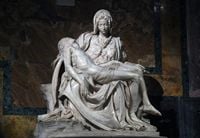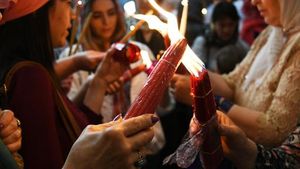Today, April 18, 2025, is Good Friday, a day steeped in solemnity and reverence, known in some traditions as Black Friday. This day marks the crucifixion of Jesus Christ, a pivotal moment in Christian faith. Across the globe, churches hold significant rituals to commemorate this event, with many congregations participating in time-honored traditions that evoke deep spiritual reflection.
In Romania, particularly in the city of Galați, the rituals have been vibrant and heartfelt. The Archbishop of Dunărea de Jos, His Eminence Casian, led the Denia of the Epitaph of the Lord, a service rich in symbolism and emotion. As part of the observance, the Epitaph, representing the body of Christ, was taken out of the altars, allowing the faithful to engage in a unique act of worship. Worshipers passed under a table, mimicking the experience of visiting the Savior's Tomb, a gesture that carries profound meaning. This act can be performed three times, a number that symbolizes the three days Christ spent in the tomb.
During the service, believers brought flowers to symbolically lay at the "Tomb of the Savior," enhancing the atmosphere of reverence and remembrance. The Archbishop Casian reflected on the significance of this day, stating, "Christ was crucified to conquer the original sin committed by Adam and Eve, as well as death itself. Love is the medicine of resurrection, of the soul and the body." This statement resonates deeply with the faithful, emphasizing the transformative power of love and sacrifice.
As the day progresses, the faithful prepare for the final Denia, where the Lamentation of the Lord will be sung. Participants will surround the church with candles in hand, a visual representation of their faith and devotion. This evening service is expected to draw many, as it serves as a poignant reminder of Christ's suffering and the hope of resurrection.
In addition to these local traditions, the Shroud of Turin, a relic believed by many to be the burial cloth of Jesus, continues to spark interest and debate. The Shroud, which features a faint image of a crucified man, has been venerated for centuries, particularly among Catholic believers who view it as a miraculous artifact. It was first exhibited in 1354 in Lirey, France, and has since traveled through various locations, including its current home in Turin, Italy.
The Shroud's history is marked by controversy and intrigue. In 1532, it suffered damage from a fire in Chambéry, but it was later restored and moved to Turin in 1578. Scientific analysis of the Shroud has yielded mixed results. In 1978, microscopist Walter McCrone claimed that the image was painted with a diluted solution of red ocher pigment, suggesting that the Shroud may date from the Middle Ages, specifically between 1260 and 1390. This conclusion has led to skepticism among some, who argue that the samples taken for analysis may have been contaminated or taken from repaired areas of the cloth.
The Catholic Church has refrained from making an official statement regarding the Shroud's authenticity, leaving believers and skeptics to continue their debates. Supporters of the Shroud's authenticity argue that it represents a significant relic of Christian faith, while critics point to scientific findings as evidence of its medieval origins.
As the observance of Good Friday unfolds, the rituals in Galați and the ongoing discussions about the Shroud of Turin reflect a broader narrative of faith, tradition, and the quest for understanding within Christianity. The rituals serve not only as a remembrance of Christ's sacrifice but also as a communal expression of faith that binds believers together across generations.
In Galați, the participation of the community in the Denia and the procession of the Epitaph signifies a deep-rooted connection to their faith and heritage. The Archbishop's remarks about love and resurrection resonate as a call to the faithful to reflect on the deeper meanings of sacrifice, redemption, and hope.
As night falls, the faithful will gather once more to honor the memory of Christ's passion, lighting candles and singing hymns that echo through the ages. This day, marked by reflection and solemnity, serves as a reminder of the enduring power of faith and the hope of resurrection that lies at the heart of Christianity.
In conclusion, Good Friday, with its rich tapestry of rituals and traditions, invites believers to engage deeply with their faith. As they reflect on the events of the crucifixion and the significance of the Shroud of Turin, they are reminded of the profound impact of love, sacrifice, and the promise of new life.






